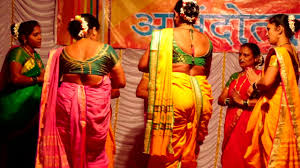Giant Puppets of India-Butta Bommalu-Gaarudi Gombe
As a Puppeteer and a researcher, I am always fascinated and drawn towards the giant puppet pageants or parades from Western Countries. Most of the Puppet festivals of Western countries surprise the world with a mechanically devised and human-controlled giant puppet that draws all our attention to it. The French street-theatre company Royal de Luxe has presented multi-day in out outdoor performances featuring their giant marionettes for millions of people around the world for more than 20 years. They have cast big puppets—Big Giant, Little Giantess, Xolo the Dog, Giant Grandmother, and Little Boy Giant in Liverpool, England. A marionette known as the Giant Grandmother is paraded through the streets of Liverpool, England, on July 25, 2014. The parade, entitled "Memories of August 1914" by the French theater company Royal de Luxe, featured the Giant Grandmother, a giant little girl, and her dog, named Xolo, and told the story of the city's involvement in World War I. there is a lot of untold stories that revolve around our life, memories, and relationship.
We too, in India have puppet plays more from Itihaasa and Puranas in common. During my journey of folklore research work, I got to see similarities between Giant-Puppets prevalent in Indian Folk art theatre in Karnataka and the Andhra Pradesh States of India. It is a combination of mask and puppet play put together as Gaarudi Gombe Kunitha. It is a festive dance form that makes use of masks and puppets. The Garudi Gombe Kunitha is also popularly known as Garudi Gombe, Tattiraaya and Maanu Bommalu or more popularly known as Butta Bommalu in Andhra Pradesh.
This particular Mask-Puppet dance has a reference from Srimad Bhagavatham. Here, Sri Krishna adorns the big mask and dances to pacify one of his consorts beautiful Satyabhama. Satyabhama, daughter of King Stayjit is known to be anxious, feisty, aggressive, highly temperamental, and argumentative amongst the queens of Sri Krishna. She always used to offer an argument, which Krishna would enjoy. Satyabhama is also known for her courage as and strong-willed woman, and her skill in archery. She even accompanied Krishna to kill the demon Narakasura. In fact, Bhama Kalapam is a special enactment in the Kuchipudi dance form.
The Gaarudi Gombe body is wrapped with colourful costumes of the regional dress. Sometimes the replica of the live human theatre i.e, Yakshagana. The face of the puppet is made out of a bamboo basket and applied on paper mache (paper pulp and in some cases even the tamarind seeds are soaked and ground to a paste along with paper pulp molded when wet and painted ) with suitable make-up. During the fair and festival procession of the temple the giant-sized dolls will be the central attraction to the onlookers. The dolls or giant-sized puppets are dummies in nature, huge dolls, in appearance; the whole structure is hollow, permitting a person to get inside to carry the entire structure on his shoulder and dance. Provision is made for the person to see from the inside. These kinds of professional puppets are also called by different names according to the region. In Coastal Karnataka this kind of doll has been called Tattiraaya. ‘Tatti’ means bamboo sticks ‘raaya’ is a suffix; the person who carried bamboo sticks huge doll or puppet.
In South Karnataka, the same dolls are also called gaarudi gombe. ‘Gaarudi’-means magical and ‘Gombe’ means- a doll. However, the use of the giant dolls in the procession is to make fun of and also to ward off the evil spirit. The giant-sized puppets are usually found during the temple festivals and they depict various social characters from Indian folk and classical. The performance of dance is in tune with the tamate and dholu or regional folk theatre instruments. The total weight of each doll is usually 10 to 12 kilograms, and height remains normally 10 feet to 12 feet. During the procession, a few performers wear simple masks of different characters and enact with giant-sized dolls. Putting on disguises like a tiger (hulivesha) or bear (karadi-vesha) and bringing monkeys to dance to the tamers tune are itinerants common to South India.
Butta Bommalu is a popular dance form in the state of Andhra Pradesh. It is the foster child of the West and East Godavari districts of Andhra Pradesh. The name Butta Bommalu literally means puppets made in the form of a basket. Butta Bommalu or the basket puppets are made out of thin bamboo strips. These strips are woven into the shape of long spherical basket figures. The performer of Butta Bommalu gets into the huge, hollow figure, the puppet. The performance starts with the dancer moving to the rhythm of four dappus, a musical instrument. It is generally performed in an open space. The puppet figure is about 8-10 tall and it has a radius of three feet. The figure is hollow at the bottom it is from there that the performer gets into the puppet. The puppet is tied down to the performer's waist and shoulders. Being made out of bamboo strips, the figures are very light. It becomes very easy for the performer to carry the figure easily. Highlights in any religious procession, these huge dancing figures are a special attraction in the festivities in Andhra Pradesh.
Provisions are made for the performer to see outside. As the dolls weigh a lot, most of the performers are usually men. The dancers also take turns carrying the dolls as the performance can go on for almost eight hours.

It’s indeed fascinating to see these kinds of
Giant Puppet performances within our region. As an art lover, we hold the
responsibility of preserving and protecting the aliveness of the art form for the
coming generation as untold treasures of humanity and culture.

















Comments
Thank you very much for going through the blogpost